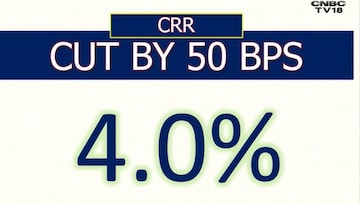
| Company | Value | Change | %Change |
|---|
While it aims to boost liquidity in the banking system, the question remains: Will this be enough to prompt banks to lower their deposit rates?

Insights from Union Bank of India’s research team suggest that the answer may not be so straightforward.
Limited impact on deposit rates
According to Union Bank of India’s Banking Research Team, the CRR cut, which is expected to release ₹1.16 lakh crore into the system, might not significantly drive banks to reduce deposit rates.
The liquidity boost, while notable, only partially offsets the permanent loss from foreign exchange (FX) outflows, which total around ₹2.95 lakh crore.
The profitability impact of the CRR cut on net interest margins (NIMs) is also relatively limited, with an estimated reduction of only 3-4 basis points (bps).
This minimal impact on profitability may not be sufficient for banks to lower their deposit rates significantly.
Why are deposit rates not coming down?
Several factors explain why deposit rates remain elevated despite the CRR cut and the convergence of credit and deposit growth:
Merger effects and competition: The recent mergers of non-banking financial institutions (NBFCs) with banks have temporarily elevated the credit-deposit (CD) ratio.
These mergers have created a competition for deposits as banks work to stabilise their CD ratios.
This competition is expected to keep deposit rates from falling in the short term.
Liquidity coverage ratio (LCR) pressures:
Banks are preparing for the implementation of revised LCR guidelines, expected in FY26. These guidelines will require banks to hold a higher proportion of high-quality liquid assets (HQLA), potentially reducing the funds available for credit creation.
This could lead to higher competition for deposits as banks work to maintain liquidity, further preventing a reduction in deposit rates.
Declining CASA ratios: Banks are also facing downward pressure on their current account-savings account (CASA) ratios.
A lower CASA ratio leads to a higher cost of funds for banks, making it more challenging to reduce deposit rates, especially for term deposits.
Repricing of deposits nearly complete: Union Bank’s report highlights that the repricing of deposits has almost run its course across the banking system.
While future trends in deposit rates are closely monitored, there is little room for further downward adjustments in the current market environment.
Credit-deposit growth convergence
The RBI’s Financial Stability Report (FSR) highlighted the convergence of credit and deposit growth rates. As per Union Bank’s analysis, credit growth has converged with deposit growth, rather than the other way around.
While credit growth is expected to recover in the upcoming busy season, early trends suggest that it may not rebound as strongly as anticipated, which could further delay any potential decrease in deposit rates.
The outlook for FY25
Looking ahead to FY25, Union Bank’s research suggests that deposit growth is expected to remain in the range of 11-11.5%. If the incremental credit-deposit ratio stays between 80-85%, credit growth is projected to drop to 11%-11.5% from 16% last year, excluding merger effects.
This slowing credit growth could reduce pressure on deposit rates, but the key determinants will be the overall liquidity dynamics, regulatory changes like the LCR implementation, and competition among banks.
The bottomline
Despite the liquidity infusion from the 50bps CRR cut, banks may not reduce their deposit rates significantly in the near term. The competition for deposits, regulatory pressures, and the evolving credit-deposit growth dynamics are likely to keep rates elevated.
Banks may, however, consider shifting their funding mix away from high-cost bulk deposits to manage their funding costs more efficiently.
Catch all updates related to RBI policy here



